13 Things You Might Not Know About Eva Perón

From 1946 to 1952, Eva Perón (full name: María Eva Duarte de Perón—though she was born Eva María Ibarguren) was Argentina’s First Lady. Nicknamed Evita, she became a massively popular celebrity and icon to Argentinians, as well as a source of great controversy. Her life inspired the Tim Rice and Andrew Lloyd Webber Broadway musical Evita (which became the 1996 film version starring Madonna), but there’s much more to the real Evita’s life. Here are 13 facts about Perón in honor of her birthday.
1. ALTHOUGH HER FATHER WAS WEALTHY, SHE GREW UP IN POVERTY.
Eva’s father, Juan Duarte, was a wealthy farmer who raised livestock and grew crops. The only problem was that he already had a wife and kids, so she, her mother, and her four older siblings were Duarte’s second family. Because they were born out of wedlock, Perón and her siblings were legally illegitimate; when Duarte abandoned them to return to his first wife, he left them impoverished in rural Argentina. Eva was 6 years old when her father died in 1926, and though her family was allowed to quickly pay their respects, they were not allowed to attend his funeral.
2. AS A YOUNG TEENAGER, SHE MOVED TO BUENOS AIRES TO BE AN ACTRESS.
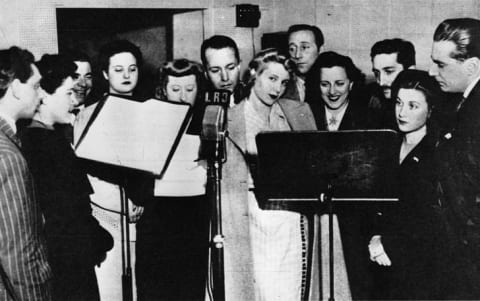
In her early teens (most sources say she was 15), Perón left home to be an actress in Buenos Aires, the capital of Argentina. Although some of her early biographical information is sketchy, most historians agree that the story (which appears in the musical Evita) that she ran off to Buenos Aires with Augustín Magaldi, a tango singer, is apocryphal. In Buenos Aires, Perón got work as a radio actress and acted in plays and films. By the early 1940s, she had achieved major financial success with her radio show on Radio Belgrano.
3. SHE MET HER HUSBAND THANKS TO AN EARTHQUAKE.
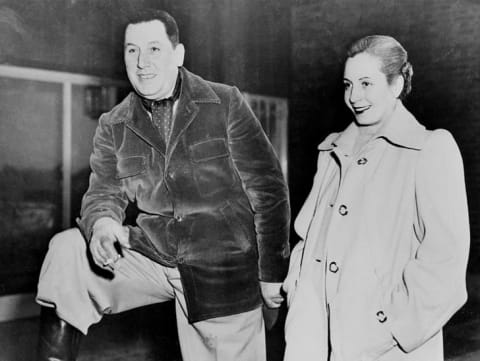
In January 1944, an earthquake in San Juan, Argentina killed an estimated 10,000 people. The military colonel Juan Perón, who headed Argentina’s Ministry of Labor, organized a fundraiser to help the victims of the earthquake. As an actress and radio show host, Perón was invited to attend, and she met her future husband at the fundraiser’s gala at Luna Park Stadium. Despite their age difference—she was in her mid-twenties, and he was in his late forties—they got married in 1945.
4. SHE BECAME A SUPER-INVOLVED AND ACTIVE FIRST LADY.
Perón broke gender barriers in Argentina by campaigning with her husband, who won Argentina’s 1946 presidential election. As First Lady, she was no less involved. Perón unofficially took over the Ministries of Health and Labor, devoted a huge amount of time to meeting with poor Argentinians, visited hospitals and orphanages, and founded the Female Perónist Party, a political party comprised of female voters.
5. HER FOUNDATION HELPED SICK AND POOR ARGENTINIANS.

In July 1948, Perón established the María Eva Duarte Social Help Foundation (renamed two years later as the Eva Perón Foundation) to fight poverty in Argentina. She worked long hours giving money and medicine to the poor, touching and kissing the sick, and empathizing with the plight of the descamisados (the poor workers; literally, "shirtless ones"). Funding for her foundation came from unions, taxes and levies, and businesses that were pressured or forced to contribute money. Perón’s foundation gave items such as shoes, cookware, and clothing to needy Argentinians, and it funded the building of hospitals, schools, and housing for homeless women and children.
6. EVITA CITY WAS DESIGNED IN THE SHAPE OF HER PROFILE.
Located in the greater Buenos Aires area, Ciudad Evita (Evita City) was named by the Eva Perón Foundation, which funded the suburb for working class Argentinians to live in. But it’s not just named after Perón—it also resembles her. An aerial view of the city reveals that Evita City was built in the shape of her profile, with her head facing right and her hair tied in her signature chignon. After military coups in 1955 and 1976 overthrew Juan Perón and pro-Perón leaders, Evita City was renamed twice. But the city’s current name is back to Ciudad Evita, and around 70,000 people live there today.
7. SHE TRAVELED TO EUROPE ON A “RAINBOW TOUR.”
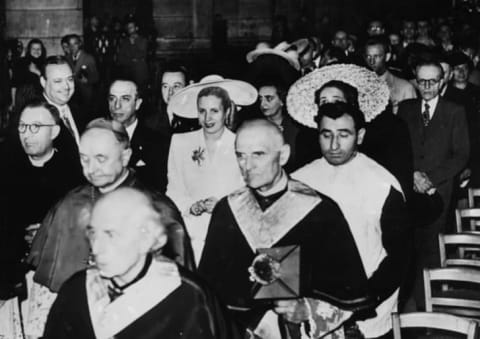
Perón at Notre Dame Cathedral in Paris in 1947.
In 1947, Perón traveled to Spain, Italy, France, and Switzerland. Dubbed the “Rainbow Tour,” Perón’s goodwill trip included meetings with Francisco Franco, Pope Pius XII, and Charles de Gaulle. Dressed to the nines, she gave money to poor children in Spain, visited the Palace of Versailles, and encountered protesters in Switzerland who threw stones and tomatoes at her. Some Europeans distrusted aspects of Juan Perón’s fascist rule and ties to Nazi war criminals, while others disapproved of what they viewed as her ostentatious "famewhoring."
8. YOU CAN SEE HER ELABORATE CLOTHING AT THE OFFICIAL EVITA PERÓN MUSEUM.
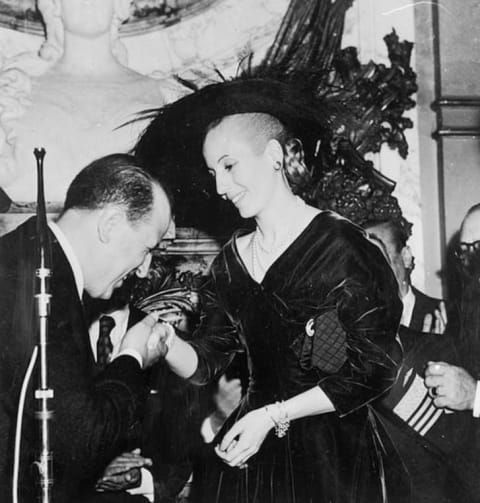
In July 2002, to commemorate 50 years since her death, Museo Evita (The Evita Museum) opened in Palermo, Buenos Aires. Founded by Cristina Alvarez Rodriquez, Perón’s grand-niece, the museum is housed in a building that the Eva Perón Foundation set up for homeless women and children to live in until they found work and a more permanent home. Visitors to the museum can see Perón’s portraits and designer clothing on display—she famously wore Dior dresses, tailored suits, and eye-catching jewelry, especially after her return from Europe.
9. SHE HELPED ARGENTINIAN WOMEN WIN THE RIGHT TO VOTE.
Perón believed that all women should have the right to vote, so she gave radio addresses, wrote articles, and made speeches at rallies supporting women’s suffrage. Although some scholars argue that her real political power in gaining women’s suffrage may have been exaggerated, she nevertheless succeeded in her goal. Argentina’s senate sanctioned the women’s suffrage bill in 1946, and it became law in 1947, making it legal for women to vote and run for office.
10. CANCER PREVENTED HER FROM RUNNING FOR VICE PRESIDENT.
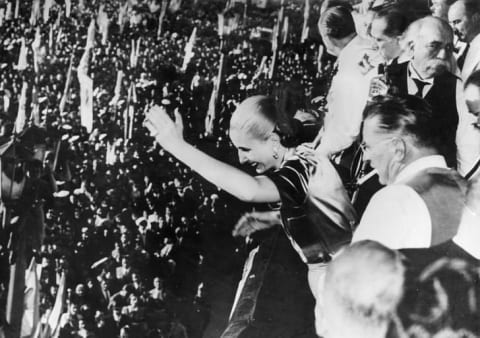
In January 1950, Perón fainted and was diagnosed with advanced cervical cancer (though other sources say she had uterine cancer). She underwent various procedures including a hysterectomy, and she was the first Argentine to undergo chemotherapy, but the cancer metastasized. In 1951, she announced her candidacy for vice president to her husband as president. Millions of working class Argentinians and members of labor unions supported her, but members of the military elite did not. Due to their opposition as well as her cancer—she was weak, thin, and in great pain—she decided to withdraw from the race.
11. SHE MAY HAVE HAD A LOBOTOMY IN A LAST-DITCH EFFORT TO EASE HER PAIN.
Perón’s medical records suggest that she may have had a prefrontal lobotomy in June 1952, a month before she died. Although the purpose of the lobotomy was to control the pain and anxiety caused by her advanced cancer, a neurosurgeon at Yale argued that Juan Perón also ordered the lobotomy as part of a political conspiracy, trying to control her violent, erratic behavior and silence her to prevent a civil war. Despite the possible motives or surgery, she died on July 26, 1952 at 33 years old.
12. MILLIONS OF MOURNERS ATTENDED HER FUNERAL.

Although she had detractors who despised her and viewed her as a megalomaniac, millions of Argentinians loved her and saw her as a saint. Before she died, Argentina’s Congress gave Perón the official title of “Spiritual Leader of the Nation.” Her state funeral was fitting for a queen, and throngs of weeping people stood outside the president’s house, mourning her death with flowers. Three million people in Buenos Aires reportedly attended her funeral and mass, and long lines of people waited to see her body on display at the Ministry of Labor.
13. HER CORPSE WAS MISSING FOR 16 YEARS.
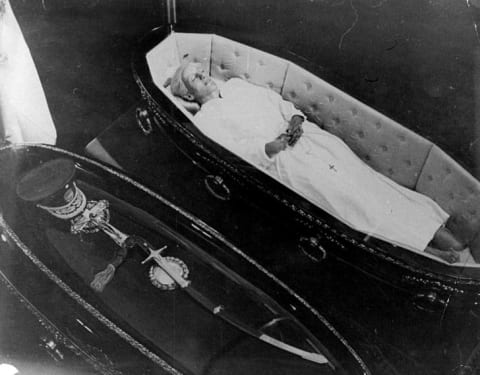
The bodies of Juan and Eva Perón on display in Buenos Aires.
After her body was embalmed and put on display, a military coup overthrew Juan Perón in 1955. He fled to Spain, and the new military leaders banned anything that was pro-Perón. They removed Eva Perón’s corpse, reportedly made wax decoy bodies to confuse her supporters, and stored the real corpse in a van and then an office. In 1957, they sent the body to a cemetery in Milan, Italy, to be buried under a fake name.
Her corpse stayed in Milan until 1971, when it was disinterred and given to Juan Perón in Madrid. Because the body was damaged, he and his third wife, Isabel, brushed her hair, cleaned the body, and put it on display in their dining room. By 1973, Juan Perón had come out of exile and won the Argentinian presidency again (with Isabel as his vice president). He died in office the following year, and Isabel had Evita's corpse returned to Buenos Aires, where it was put on display next to Juan Perón’s corpse for a time. Finally, in 1976, her body was buried in her maiden family’s tomb in a secure, tamper-proof spot in a cemetery in Buenos Aires.
All images via Getty.